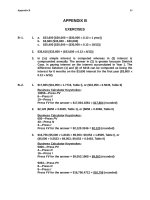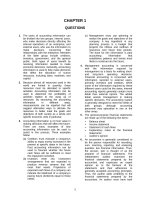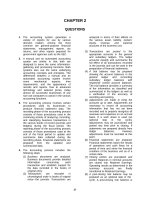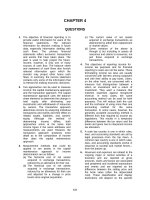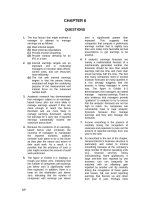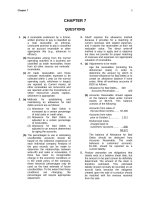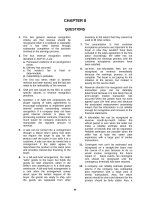Solutions manual intermediate accounting 18e by stice and stice ch05
Bạn đang xem bản rút gọn của tài liệu. Xem và tải ngay bản đầy đủ của tài liệu tại đây (268.27 KB, 48 trang )
To download more slides, ebook, solutions and test bank, visit
CHAPTER 5
QUESTIONS
1. Cash flow from operations can offer a
clearer picture of a company's performance
than does net income when:
•
A company reports large noncash expenses, such as write-offs, depreciation, and provisions for future obligations. Earnings may give an overly
pessimistic view of the firm.
•
A company is growing rapidly. Reported earnings may be positive, but
operations are actually consuming rather than generating cash.
•
A company badly needs to report favorable earnings, as is the case before
a major loan application or before a
stock offering. In these cases, cash
flow from operations provides an excellent reality check for reported earnings.
2. To qualify as a cash equivalent when preparing a statement of cash flows, an item
must be
(a) readily convertible to cash, and
(b) so near its maturity that there is insignificant risk of changes in value due to
changes in interest rates.
As a general rule, only investments with
original maturities of three months or less
qualify. The original maturity is determined
from the date of acquisition of the investment by the entity, not the date of original
issuance of the security.
3. Operating activities include those transactions and events that enter into the determination of net income. Cash receipts from
selling goods or from providing services are
the major cash inflow for most businesses.
Major cash outflows include payments to
purchase inventory and to pay wages,
taxes, interest, utilities, rent, and similar
expenses.
Investing activities are the purchase and
sale of land, buildings, and equipment and
the purchase and sale of financial instruments not intended for trading purposes.
4.
5.
6.
7.
Financing activities include transactions
and events whereby cash is obtained from
or repaid to owners (equity financing) and
creditors (debt financing).
The normal pattern of cash flow is
•
Operating—positive
•
Investing—negative
•
Financing—either positive or negative
The direct method reports all operating
cash receipts and cash payments. The difference between cash receipts and payments is the net cash flow from operations.
The indirect method begins with net income
as reported on the income statement, adjusts for any noncash items (such as depreciation), and converts the accrual
amounts to a cash basis. The result of this
reconciliation process is net cash flow from
operations, which will be exactly the same
amount as derived using the direct method.
Many users favor the direct method because it is a straightforward approach that
is easy to understand. Most accountants
prefer the indirect method because it is
easy to apply and because it helps explain
or reconcile the differences between net
cash flow from operations and net income.
Because accountants already have to report net income, it is easier for them to start
with that number and convert it to net cash
flow from operations rather than use the direct method.
When the direct method is used, depreciation expense is omitted from the calculation
of cash from operating activities because it
is a noncash expense. When the indirect
method is used, depreciation expense is
added back to net income because depreciation was subtracted in the original computation of net income.
8. The statement, “Cash flow is equal to net
income plus depreciation” is wrong because it ignores the impact on cash from
operating activities of all the changes in
current operating assets and current operating liabilities.
145
To download more slides, ebook, solutions and test bank, visit
146
9. The FASB treats interest payments as an
operating activity in order to be consistent
with the income statement presentation.
The FASB defines interest payments as
operating activities because interest expense enters into the calculation of net income. The FASB considered classifying interest payments as financing activities but
ultimately decided on the operating activity
classification.
10. The “target number” is the net change in
the cash balance, as shown in the balance
sheet. The sum of cash flows from operating, investing, and financing activities
should equal the net change in cash.
11. Cost of goods sold, combined with the
change in the inventory balance, reveals
how much inventory was purchased during
the year. Inventory purchases, coupled with
the change in the accounts payable balance for the year, are used to calculate the
amount of cash paid for inventory purchases.
12. A loss on the sale of a long-term asset is
omitted from the calculation of cash from
operating activities when using the direct
method. When the indirect method is used,
the loss is added back to net income because the loss was subtracted in the original computation of net income. In both
cases, any effects of the sale of the longterm asset are removed from the computation of operating cash flow; cash received
from the sale of long-term assets is reported as an investing activity.
13. The FASB has defined all transactions
involving available-for-sale and held-tomaturity securities as investing activities.
Transactions involving trading securities
are usually included in the Operating Activities section.
14. If the direct method is used, a separate
schedule must be presented to reconcile
net income to net cash provided by (used
in) operating activities. If a company elects
to use the indirect method, the amounts
paid during the period for interest and income taxes should be disclosed. Regardless of the method used for reporting operating cash flows, companies must disclose
any significant noncash investing and financing transactions. The supplemental
disclosures required by FASB ASC Topic
Chapter 5
15.
16.
17.
18.
19.
20.
21.
230 can be provided in the notes to the financial statements or in separate schedules accompanying the statement of cash
flows.
Significant noncash investing and financing
transactions (e.g., the purchase of land by
issuing capital stock) are to be reported in
the notes to the financial statements or in a
separate schedule accompanying the cash
flow statement. Because these transactions
do not affect cash, they should not be reported on the statement of cash flows itself.
Under FASB ASC Topic 230, interest paid
is classified as an operating activity.
Cash from operations is usually larger than
net income. This is because of the large
number of noncash expenses included in the
income statement, such as depreciation,
write-downs, and restructuring charges.
When the value of a company’s cash flow
adequacy ratio is less than 1.0, that company is not generating enough cash from
operations to pay for all new plant and
equipment purchases. Accordingly, the
company has no cash left over to repay
loans or to distribute to investors.
The income statement details the transactions that occurred in temporary accounts
that are summarized in the retained earnings account. The statement of cash flows
provides information relating to transactions
that occurred in the cash account for the
period.
A forecasted statement of cash flows allows management to see the relationship
between forecasted operating cash flow
and the cash needed for investing activities. If there is an expected shortfall in
available cash, a company can either use
the forecasted information in obtaining additional financing or the company can scale
back its expansion plans in order to reduce
the drain on cash.
Lenders can use a forecasted statement of
cash flows to see whether it seems likely
that a company can continue to meet its existing debt obligations. An investor can use
the projected cash flow statement to evaluate the likelihood that a company will be
able to continue making dividend payments.
To download more slides, ebook, solutions and test bank, visit
Chapter 5
147
PRACTICE EXERCISES
PRACTICE 5–1
CASH AND CASH EQUIVALENTS
(a)
Not cash equivalent because it is an equity investment; no maturity date.
(b)
Cash equivalent of $7,250 because time to maturity at date of purchase was less
than three months.
(c)
Cash of $3,400.
(d)
Not cash equivalent because time to maturity at date of purchase was greater
than three months.
$7,250 + $3,400 = $10,650
PRACTICE 5–2
THREE CATEGORIES OF CASH FLOWS
Cash Inflow
(Outflow)
Operating
(d) Cash collected from customers..................................................
(b) Cash paid for interest ..................................................................
(f) Cash paid for income taxes ........................................................
Total .......................................................................................................
$13,400
(600)
(1,850)
$10,950
Investing
(a)
Cash received from sale of a building .......................................
$ 4,200
Financing
(c) Cash paid to repurchase shares of stock (treasury stock)......
(e) Cash paid for dividends ..............................................................
Total .......................................................................................................
PRACTICE 5–3
CASH FLOW PATTERNS
Company A
Company B
Company C
steady state
start-up, high growth
cash cow
$ (1,100)
(930)
$ (2,030)
To download more slides, ebook, solutions and test bank, visit
148
PRACTICE 5–4
Chapter 5
NONCASH INVESTING AND FINANCING ACTIVITIES
(a)
(b)
(c)
(d)
Investing
$(40,000)
0
0
0
Total
$(40,000)
PRACTICE 5–5
Financing
$
0
0
0
56,000
(30,000)
$ 26,000
Noncash
(Disclose only)
$ 80,000
67,000
100,000
GENERAL FORMAT FOR A STATEMENT OF CASH FLOWS
Cash flow from operating activities.........................................
Cash flow from investing activities .........................................
Cash flow from financing activities .........................................
Net decrease in cash.................................................................
Cash balance, beginning of year .............................................
Cash balance, end of year ........................................................
PRACTICE 5–6
CASH COLLECTED FROM CUSTOMERS
Accounts receivable, beginning ..............................................
Plus: Sales..................................................................................
Cash available for collection ....................................................
Less: Accounts receivable, ending .........................................
Cash collected from customers ...............................................
PRACTICE 5–7
$ 6,200
(9,400)
5,000
$ 1,800
2,800
$ 4,600
$ 1,400
10,000
$11,400
(1,375)
$10,025
CASH PAID FOR INVENTORY PURCHASES
Inventory, ending.......................................................................
Plus: Cost of goods sold ..........................................................
Required inventory ....................................................................
Less: Beginning inventory .......................................................
Inventory purchased this year .................................................
$ 2,100
5,300
$ 7,400
(2,500)
$ 4,900
Accounts payable, beginning...................................................
Plus: Inventory purchased this year........................................
Accounts to be paid ..................................................................
Less: Accounts payable, ending..............................................
Cash paid for inventory purchases .........................................
$ 1,350
4,900
$ 6,250
(1,200)
$ 5,050
To download more slides, ebook, solutions and test bank, visit
Chapter 5
149
PRACTICE 5–8
CASH PAID FOR OPERATING EXPENSES
Prepaid operating expenses, ending.......................................
Plus: Operating expenses ........................................................
Required cash outlay for operating expenses........................
Less: Prepaid operating expenses, beginning .......................
Cash paid for operating expenses this year ...........................
PRACTICE 5–9
DIRECT METHOD
Income Statement
Sales
Cost of goods sold
$ 7,800
(3,100)
Interest expense
Depreciation expense
Net income
(450)
(600)
$ 3,650
Adjustments
Statement of
Cash Flows
+ 320
+ 180
– 210
+ 80
+ 600
Direct Method:
Cash collected from customers ...............................................
Cash paid for inventory purchases .........................................
Cash paid for interest................................................................
Net cash flow from operating activities...................................
PRACTICE 5–10
$ 700
3,800
$ 4,500
(1,000)
$ 3,500
$ 8,120
(3,130)
(370)
0
$ 4,620
$ 8,120
(3,130)
(370)
$ 4,620
INDIRECT METHOD
Income Statement
Sales
Cost of goods sold
$ 7,800
(3,100)
Interest expense
Depreciation expense
Net income
(450)
(600)
$ 3,650
Adjustments
Statement of
Cash Flows
+ 320
+ 180
– 210
+ 80
+ 600
Indirect Method:
Net income .................................................................................
Plus: Depreciation ....................................................................
Plus: Decrease in accounts receivable ..................................
Plus: Decrease in inventory ....................................................
Less: Decrease in accounts payable ......................................
Plus: Increase in interest payable...........................................
Net cash flow from operating activities...................................
$ 8,120
(3,130)
(370)
0
$ 4,620
$3,650
600
320
180
(210)
80
$4,620
To download more slides, ebook, solutions and test bank, visit
150
PRACTICE 5–11
Chapter 5
COMPLETE STATEMENT OF CASH FLOWS FROM DETAILED
DATA
Operating activities:
(f) Cash collected from customers........................................................
(b) Cash paid to purchase inventory .....................................................
(d) Cash paid for interest ........................................................................
(j) Cash paid for income taxes ..............................................................
Net cash flow from operating activities....................................................
$11,200
(7,800)
(450)
(1,320)
$ 1,630
Investing activities:
(c) Cash received from sale of a building .............................................
(k) Cash paid to purchase machinery ...................................................
Net cash flow from investing activities ....................................................
$ 4,750
(1,950)
$ 2,800
Financing activities:
(e) Cash paid to repay a loan..................................................................
(h) Cash received from issuance of new shares of common stock ...
(i) Cash paid for dividends ....................................................................
Net cash flow from financing activities ....................................................
$ (1,000)
1,200
(780)
$ (580)
Net increase in cash...................................................................................
Cash balance, beginning of year ..............................................................
Cash balance, end of year .........................................................................
$ 3,850
1,500
$ 5,350
PRACTICE 5–12
OPERATING CASH FLOW: GAINS AND LOSSES
Net income .................................................................................
Plus: Depreciation .....................................................................
Less: Gain on sale of equipment .............................................
Plus: Loss on sale of building..................................................
Less: Increase in accounts receivable ....................................
Less: Decrease in income taxes payable................................
Net cash flow from operating activities...................................
PRACTICE 5–13
$ 250
1,000
(440)
210
(300)
(170)
$ 550
OPERATING CASH FLOW: RESTRUCTURING CHARGES
Net income .................................................................................
Plus: Depreciation .....................................................................
Plus: Restructuring charge ......................................................
Plus: Decrease in inventory .....................................................
Plus: Increase in wages payable..............................................
Net cash flow from operating activities...................................
$ 500
1,000
2,300
300
170
$4,270
To download more slides, ebook, solutions and test bank, visit
Chapter 5
PRACTICE 5–14
151
OPERATING CASH FLOW: DEFERRED INCOME TAXES
Reported income tax expense...................................................................
Less: Increase in deferred tax liability .....................................................
Taxes owed for current year operations ..................................................
Less: Increase in income taxes payable ..................................................
Cash paid for income taxes.......................................................................
PRACTICE 5–15
OPERATING CASH FLOW: DEFERRED, OR UNEARNED, SALES
REVENUE
Sales ............................................................................................................
Plus: Accounts receivable, beginning......................................................
Less: Deferred sales revenue, beginning (cash already collected) ......
Cash available for collection this year .....................................................
Less: Accounts receivable, ending ..........................................................
Plus: Deferred sales revenue, ending (collected for future years)........
Total cash collections from customers....................................................
PRACTICE 5–16
$35,500
(3,500)
$32,000
(390)
$31,610
$10,000
1,430
(750)
$10,680
(1,250)
1,000
$10,430
OPERATING CASH FLOW: PREPAID OPERATING EXPENSES
Cash paid for depreciation ........................................................................
$
Cash paid for insurance:
Prepaid insurance, ending ................................................................
Plus: Insurance expense ...................................................................
Required cash outlay for insurance .................................................
Less: Prepaid insurance, beginning ................................................
Cash paid for insurance this year ....................................................
$ 1,500
7,500
$ 9,000
(1,430)
$ 7,570
Cash paid for wages:
Wages payable, beginning ................................................................
Plus: Wage expense this year...........................................................
Wages to be paid................................................................................
Less: Wages payable, ending ...........................................................
Cash paid for wages this year ..........................................................
$ 750
14,600
$15,350
(600)
$14,750
Cash paid for operating expenses: $0 + $7,570 + $14,750 = $22,320
0
To download more slides, ebook, solutions and test bank, visit
152
PRACTICE 5–17
Chapter 5
COMPUTING CASH PAID TO PURCHASE PROPERTY, PLANT,
AND EQUIPMENT
PPE, beginning .........................................................................
Less: PPE sold during the year...............................................
Ending PPE without purchase of new PPE............................
$124,000
28,000
$ 96,000
PPE, ending...............................................................................
Less: Ending PPE without purchase of new PPE .................
Cash paid to purchase new PPE.............................................
$134,000
96,000
$ 38,000
This assumes that all PPE purchases were for cash.
PRACTICE 5–18
COMPUTING CASH RECEIVED FROM THE SALE OF PROPERTY,
PLANT, AND EQUIPMENT
Accumulated depreciation, beginning ...................................
Plus: Depreciation expense.....................................................
Ending accumulated depreciation without PPE sale............
Less: Actual ending accumulated depreciation ....................
Accumulated depreciation associated with PPE sold ..........
$41,000
9,700
$50,700
32,000
$18,700
Original cost of PPE sold.........................................................
Accumulated depreciation associated with PPE sold ..........
Book value of PPE sold ...........................................................
$28,000
18,700
$ 9,300
Book value of PPE sold ...........................................................
Plus: Gain on sale of PPE........................................................
Cash received from sale of PPE..............................................
$ 9,300
6,500
$15,800
PRACTICE 5–19
COMPUTING CASH PAID FOR DIVIDENDS
Retained earnings, beginning .................................................
Plus: Net income.......................................................................
Ending retained earnings without dividend declarations ....
Less: Actual ending retained earnings ..................................
Dividends declared during the year........................................
$106,000
10,000
$116,000
112,000
$ 4,000
Dividends declared during the year........................................
Plus: Decrease in dividends payable .....................................
Cash paid for dividends this year ...........................................
$
$
4,000
250
4,250
To download more slides, ebook, solutions and test bank, visit
Chapter 5
PRACTICE 5–20
1.
153
COMPUTING CASH FLOW RATIOS
Cash-flow-to-net-income
Cash flow from operating activities ...............................
Net income ........................................................................
Cash-flow-to-net-income ratio ........................................
2.
3.
Cash flow adequacy
Cash paid for capital expenditures ................................
Cash paid for acquisitions ..............................................
Cash required for investing activities ............................
$
Cash flow from operating activities ...............................
Cash required for investing activities ............................
Cash flow adequacy ratio................................................
$ 21,000
÷ $34,500
0.61
$
23,500
11,000
34,500
Cash times interest earned
Cash flow from operating activities ...............................
Cash paid for interest ......................................................
Cash paid for income taxes ............................................
Operating cash flow before interest and taxes .............
Cash paid for interest ......................................................
Cash times interest earned ratio ....................................
PRACTICE 5–21
a.
$ 21,000
÷ $18,000
1.17
$ 21,000
3,800
6,700
$ 31,500
÷ $3,800
8.29
ARTICULATION
Cash increased by $10,500 during the year ($22,500 – $12,000)
Cash from operating activities........................................
Cash from investing activities ........................................
Cash from financing activities ........................................
Increase in cash ...............................................................
$
?
(25,000)
(8,000)
$ 10,500
Cash from operating activities = $43,500
b.
At the beginning of the year: Assets = Liabilities + Owners’ equity
$239,000 = $117,000 + ?
Owners’ equity at the start of the year = $122,000 of which $21,000 represents
common stock and $101,000 represents retained earnings.
Dec. 31 Retained earnings = Jan. 1 Retained earnings + Net income – Dividends
$105,000 = $101,000 + Net income – $8,000
Net income = $12,000
To download more slides, ebook, solutions and test bank, visit
154
PRACTICE 5–22
Chapter 5
PREPARING A FORECASTED STATEMENT OF CASH FLOWS
Operating activities:
Net income ........................................................................
Plus: Depreciation ..........................................................
Less: Increase in accounts receivable .........................
Less: Increase in inventory............................................
Plus: Increase in accounts payable..............................
Net cash flow from operating activities..................................
$ 2,275
1,200
(180)
(390)
150
$ 3,055
Investing activities:
Cash paid for PPE purchases
($1,300 PPE increase
+ $1,200 depreciation replacement) ...............................
Financing activities:
New long-term debt..........................................................
New paid-in capital...........................................................
Cash paid for dividends
($1,500 + $2,275 − $1,850 = $1,925) ................................
Net cash flow from financing activities ..................................
Net increase in cash.................................................................
Cash, beginning........................................................................
Cash, ending .............................................................................
(2,500)
$ 1,000
400
(1,925)
(525)
$
30
100
$ 130
To download more slides, ebook, solutions and test bank, visit
Chapter 5
155
EXERCISES
5–23.
(a)
(b)
(c)
(d)
(e)
(f)
(g)
(h)
(i)
(j)
(k)
(l)
(m)
(n)
(o)
(p)
Operating activity
Operating activity
Operating activity
Financing activity
Financing activity
Financing activity
Operating activity
Financing activity
Investing activity
Investing activity
Operating activity
Operating activity
Operating activity
Operating activity
Noncash transaction; report separately.
Noncash item; ignore under direct method; add back to net income under indirect method.
(q) Investing activity
(r) Investing activity
5–24.
(a) The purchase of securities classified as available-for-sale is reported as
cash used to acquire those securities, an investing activity.
(b) The acquisition of buildings for $60,000 should be reported as a use of
cash from investing activities. The balance ($150,000) is a significant
noncash transaction that should be reported separately in the notes or
an accompanying schedule to the statement of cash flows.
(c) The purchase of business assets is reported as an investing activity as
follows:
Cash was used to:
Purchase inventory..............................................
$16,700
Purchase furniture and fixtures..........................
8,400
Purchase land and buildings ..............................
20,100
Purchase goodwill ...............................................
9,000
$54,200
Note that the entire amount of the business purchase is reported as a cash
outflow from investing activities even though some of the assets ($16,700
in inventory) are operating assets.
(d) The declaration of dividends is not reported as a use of cash because
this had no effect on cash. When the dividend payable is paid, the cash
outflow will be shown as a financing activity.
(e) The decrease in Accounts Payable is reported as an item to be deducted in computing net cash flow provided by (used in) operations.
Cash payments for purchases includes payment for purchases of the
previous period.
To download more slides, ebook, solutions and test bank, visit
156
5–25.
Chapter 5
(a) $15,500 of cash used to purchase equipment; $16,000 of cash provided
from sale of equipment. Both are investing activities. (Note: The $2,000
loss on sale would be added to net income when using the indirect method.)
Equipment
Beginning balance
Purchase of equipment
62,000
15,500
Ending balance
56,500
Sale of equipment
21,000
(b) No cash is provided or used by depreciation; however, $4,100 is added
to net income for yearly depreciation in showing net cash flow provided
by operations when using the indirect method.
Accumulated Depreciation
Sale of equipment
3,000
Beginning balance
Depreciation for year
12,800
4,100
Ending balance
13,900
(c) $5,000 ($25,000 – $20,000) of cash used to pay off a portion of long-term
debt, a financing activity.
(d) $4,000 ($16,000 – $12,000) of cash provided from issuance of common
stock, a financing activity.
5–26.
Income Statement
Sales
Cost of goods sold
$ 278,700
(197,000)
Depreciation expense
Salaries expense
Other expenses
Net income
(16,700)
(35,200)
(24,300)
$ 5,500
(a)
Operating activities:
Cash collected from customers
Cash paid for inventory
Cash paid for salaries
Cash paid for other expenses
Net cash provided by operating activities
Adjustments
– 3,600
+ 1,760
– 750
+16,700
+ 150
No adjustment
Statement of
Cash Flows
$ 275,100
(195,990)
0
(35,050)
(24,300)
$ 19,760
$275,100
$195,990
35,050
24,300
255,340
$ 19,760
To download more slides, ebook, solutions and test bank, visit
Chapter 5
5–26.
(b)
157
(Concluded)
Operating activities:
Net income
Adjustments:
Depreciation
Decrease in inventory
Increase in salaries payable
Increase in accounts receivable
Decrease in accounts payable
Net cash provided by operating activities
$ 5,500
$16,700
1,760
150
(3,600)
(750)
14,260
$19,760
5–27.
Income Statement
Sales
Cost of goods sold
$ 675,400
(243,500)
Depreciation expense
Salaries expense
Interest expense
Income taxes expense
Other expenses
Net income
(51,000)
(124,600)
(11,300)
(44,000)
(98,700)
$ 102,300
(a) Operating activities:
Cash collected from customers
Cash paid for inventory
Cash paid for salaries
Cash paid for interest
Cash paid for income taxes
Cash paid for other expenses
Net cash provided by operating activities
(b) Operating activities:
Net income
Adjustments:
Depreciation
Increase in accounts payable
Increase in income taxes payable
Decrease in prepaid expenses
Increase in accounts receivable
Increase in inventory
Decrease in interest payable
Net cash provided by operating activities
Adjustments
– 5,000
– 5,800
+ 1,300
+51,000
No adjustment
– 400
+ 1,800
+ 1,100
Statement of
Cash Flows
$ 670,400
(248,000)
0
(124,600)
(11,700)
(42,200)
(97,600)
$ 146,300
$ 670,400
$248,000
124,600
11,700
42,200
97,600
(524,100)
$ 146,300
$102,300
$51,000
1,300
1,800
1,100
(5,000)
(5,800)
(400)
44,000
$146,300
To download more slides, ebook, solutions and test bank, visit
158
Chapter 5
5–28.
Carter Corporation
Statement of Cash Flows
For the Year Ended December 31, 2013
Cash flows from operating activities:
Net income....................................................................
Adjustments:
Depreciation expense...............................................
Amortization of patent..............................................
Gain on sale of land..................................................
Decrease in accounts receivable ............................
Increase in inventory ................................................
Increase in accounts payable ..................................
Net cash provided by operating activities.................
Cash flows from investing activities:
Proceeds from sale of land.........................................
Purchase of equipment ...............................................
Net cash provided by investing activities .................
Cash flows from financing activities:
Retirement of long-term debt .....................................
Issuance of bonds .......................................................
Issuance of common stock.........................................
Payment of dividends..................................................
Net cash used in financing activities.........................
Net increase in cash .......................................................
Cash balance at beginning of year ...............................
Cash balance at end of year ..........................................
$ 55,000
$ 7,000
4,000
(6,000)
2,100
(1,200)
1,500
7,400
$ 62,400
$ 35,000
(33,200)
1,800
$(40,000)
30,000
25,000
(22,500)
(7,500)
$ 56,700
82,800
$139,500
5–29.
Cash flows from operating activities:
Net income..................................................................
Adjustments:
Depreciation expense.............................................
Increase in accounts receivable............................
Decrease in accounts payable...............................
Increase in inventories ...........................................
Increase in other current liabilities .......................
Decrease in prepaid insurance..............................
Net cash provided by operating activities...............
$35,500
$ 7,000
(2,150)
(2,500)
(4,500)
2,000
1,050
900
$36,400
To download more slides, ebook, solutions and test bank, visit
Chapter 5
159
5–30.
Income Statement
Adjustments
Cash Flows
$ 6,780,000
Sales
$ 7,200,000
$(420,000)
Cost of goods
sold
(3,500,000)
110,000
(2,764,000)
170,000
420,000
36,000
Selling, general,
and administrative expenses
(2,300,000)
12,000
(2,023,000)
(15,000)
280,000
Income taxes
Net income
(500,000)
$ 900,000
54,000
(446,000)
$ 1,547,000
Increase in receivables
Decrease in
inventories
Increase in trade
payables
Amount of depreciation related to
manufacturing
Increase in accrued
expenses related to
manufacturing
Increase in accrued
expenses related to
selling
Increase in prepaid
selling expense
Amount of depreciation related to selling
Increase in taxes
payable
Cash from operating
activities
5–31.
Cash flows from operating activities:
Net income...............................................................
Adjustments:
Depreciation ........................................................
Amortization ........................................................
Decrease in accounts receivable ......................
Increase in inventory..........................................
Increase in accounts payable............................
Decrease in interest payable .............................
Net cash provided by operating activities............
$ 75,000
$50,000
20,000
7,000
(5,000)
4,500
(800)
75,700
$150,700
To download more slides, ebook, solutions and test bank, visit
160
Chapter 5
5–32.
Cash flows from operating activities:
Cash receipts from customers ..........................
Cash payments for:
Inventory ...........................................................
Operating expenses.........................................
Interest ..............................................................
Net cash provided by operating activities........
$275,500 (b)
24,800 (c)
6,000 (d) 306,300
$150,700
COMPUTATIONS:
(a) Sales..................................................................
+ Beginning accounts receivable..................
– Ending accounts receivable .......................
= Cash receipts from customers ...................
$450,000
22,000
(15,000)
$457,000
(b) Cost of goods sold (except depreciation) .....
+ Ending inventory .........................................
– Beginning inventory ....................................
= Purchases.....................................................
+ Beginning accounts payable ......................
– Ending accounts payable ...........................
= Cash paid for inventory...............................
$275,000
40,000
(35,000)
$280,000
47,500
(52,000)
$275,500
(c) Sales..................................................................
Cost of goods sold (except depreciation) .....
Gross margin....................................................
Less expenses .................................................
Net income........................................................
$450,000
275,000
$175,000
100,000*
$ 75,000
$457,000 (a)
*$175,000 gross margin – $75,000 net income = $100,000
Expenses ..........................................................
Less noncash items:
Depreciation expense ...................................
Amortization expense...................................
$100,000
$ 50,000
20,000
Less: Interest expense ....................................
Cash paid for operating expenses .................
(d) Interest expense on short-term debt for year
+ Beginning interest payable.........................
– Ending interest payable ..............................
= Cash paid for interest..................................
$
$
5,200
1,200
(400)
6,000
70,000
$ 30,000
(5,200)
$ 24,800
To download more slides, ebook, solutions and test bank, visit
Chapter 5
161
5–33.
1. Cash collected from accounts receivable:
Accounts receivable, beginning balance .............................
Sales in 2013............................................................................
Total collectible accounts ......................................................
Less: Accounts receivable, ending balance ........................
Cash collected in 2013............................................................
$ 372,000
3,946,000
$ 4,318,000
409,000
$ 3,909,000
2. Cash paid on accounts payable:
Inventory, ending balance......................................................
Add: Cost of goods sold in 2013 ...........................................
Total goods available in 2013 ................................................
Less: Inventory, beginning balance ......................................
Inventory purchases in 2013..................................................
Accounts payable, beginning balance..................................
Add: Inventory purchases in 2013.........................................
Total accounts to be paid in 2013..........................................
Less: Accounts payable, ending balance.............................
Total cash paid on accounts payable in 2013 ......................
$ 289,000
2,385,000
$ 2,674,000
304,000
$ 2,370,000
$ 174,000
2,370,000
$ 2,544,000
191,000
$ 2,353,000
3. Cash dividend payment:
Retained earnings, beginning balance .................................
Add: Net income, 2013............................................................
Less: Retained earnings, ending balance ............................
Total dividends declared ........................................................
Less: Increase in dividends payable.....................................
Total cash dividend payment in 2013....................................
$ 211,000
769,000
$ 980,000
525,000
$ 455,000
65,000
$ 390,000
4. Cash receipts not provided by operations:
Cash provided from financing:
Notes payable* ($210,000 – $106,000)...................................
Common stock ($625,000 – $600,000)...................................
Cash receipts not provided by operations ...........................
$ 104,000
25,000
$ 129,000
5. Cash payments for assets not reflected in operations:
Available-for-sale securities ..................................................
Property, plant, and equipment* ($656,000 – $541,000) ......
Cash payments for assets not reflected in operations .......
$ 400,000
115,000
$ 515,000
*If the notes payable mentioned in (4) were issued as direct payment for the
property, plant, and equipment in (5), this transaction would be a noncash
transaction and would be disclosed separately from the cash flow statement.
To download more slides, ebook, solutions and test bank, visit
162
Chapter 5
5–34.
Goulding Manufacturing Company
Statement of Cash Flows (Indirect method)
For the Year Ended December 31, 2013
Cash flows from operating activities:
Net income..................................................................
Adjustments:
Depreciation expense.............................................
Intangible assets amortization ..............................
Increase in accounts receivable............................
Increase in inventory ..............................................
Decrease in accounts payable...............................
Increase in interest payable...................................
Increase in wages payable.....................................
Net cash provided by operating activities ..............
Cash flows from investing activities:
Purchase of machinery .............................................
Net cash used in investing activities .......................
Cash flows from financing activities:
Retirement of long-term debt ...................................
Sale of common stock...............................................
Payment of dividends................................................
Net cash used in financing activities.......................
Net increase in cash and cash equivalents ...............
Cash and cash equivalents at beginning of year ......
Cash and cash equivalents at end of year .................
$450,700
$ 70,000
10,000
(19,000)
(18,000)
(23,400)
5,900
9,500
35,000
$485,700
$ (62,000)
(62,000)
$(500,000)
160,000
(22,000)
(362,000)
$ 61,700
130,000
$191,700
5–35.
1. Dec. 31 Accounts receivable = Jan. 1 Accounts receivable + Sales on
account – Cash collections
Dec. 31 Accounts receivable = $75,000 + $540,000 – $551,000
Dec. 31 Accounts receivable = $64,000
2. Dec. 31 Accounts payable = Jan. 1 Accounts payable + Inventory purchased on account – Cash paid for inventory
$56,000 = $44,000 + $279,000 – Cash paid for inventory
Cash paid for inventory = $267,000
3. Dec. 31 Inventory = Jan. 1 Inventory + Inventory purchased on account
– Cost of goods sold
$72,000 = $83,000 + $279,000 – Cost of goods sold
Cost of goods sold = $290,000
To download more slides, ebook, solutions and test bank, visit
Chapter 5
163
5–36.
1.
Dec. 31 Retained earnings = Jan. 1 Retained earnings + Net income – Dividends
$665,000 = $543,000 + Net income – $47,000
Net income = $169,000
2.
Dec. 31 Cash = Jan. 1 Cash + Cash from operating activities + Cash from investing activities + Cash from financing activities
$141,000 = $97,000 + Cash from operating activities – $483,000 – $287,000
Cash from operating activities = $814,000
5–37.
1.
2.
3.
2013
Cash-flow-to-net-income ratio
0.81
(Cash from operations ÷ Net income)
Cash flow adequacy ratio
0.69
(Cash from operations ÷ Cash paid for purchase of fixed assets)
Cash times interest earned ratio
2.69
[(Cash from operations + Cash paid for interest and taxes) ÷
Cash paid for interest]
2012
2.43
1.01
8.66
5–38.
1.
Income Statement
Sales
Cost of goods sold
2013
$3,000
1,200
Gross profit
Depreciation expense
$1,800
100
Other operating expenses
1,440
Operating profit
Interest expense
$ 260
50
Income before taxes
Income taxes
$ 210
84
Net income
$ 126
2014
Forecasted
$3,600 given
1,440
40% of sales,
same as last year
$2,160
140
20% of PP&E,
same as last year
1,728
48% of sales,
same as last year
$ 292
40
10% of bank loan,
same as last year
$ 252
101
40% of pretax,
same as last year
$ 151
To download more slides, ebook, solutions and test bank, visit
164
5–38.
Chapter 5
(Concluded)
2.
Cash flows from operating activities:
Net income..................................................................
Adjustments:
Depreciation ............................................................
Increase in other current assets............................
Increase in accounts payable ................................
Net cash provided by operating activities...............
Cash flows from investing activities:
Purchase of property, plant, and equipment ..........
Net cash used in investing activities .......................
Cash flows from financing activities:
Repayment of bank loans payable...........................
Issuance of common stock.......................................
Net cash provided by financing activities ...............
Net increase in cash and cash equivalents ...............
Cash and cash equivalents at beginning of year ......
Cash and cash equivalents at end of year .................
$ 151
$ 140
(90)
38
88
$ 239
$(340) (a)
(340)
$(100) (b)
209 (c)
109
$ 8
40
$ 48
COMPUTATIONS:
(a) Beginning property, plant, and equipment...........
Less: Depreciation expense ..................................
Ending property, plant, and equipment ................
Difference (assets purchased)...............................
$500
140
$360
700
$340
(b) Beginning bank loans payable ..............................
Ending bank loans payable....................................
Decrease (bank loans repaid) ................................
$500
400
$100
(c) Beginning stockholders’ equity ............................
Plus: Increase from forecasted net income .........
Less: Decrease from forecasted cash dividends
Total stockholders’ equity with no new stock .....
Ending stockholders’ equity..................................
Increase (common stock issued) ..........................
$300
151
(0)
$451
660
$209
To download more slides, ebook, solutions and test bank, visit
Chapter 5
165
5–39.
1.
Balance Sheet
2013
Cash
Other current assets
Property, plant, and equipment, net
Total assets
$
10
250
800
$1,060
Accounts payable
$ 100
Bank loans payable
700
Total stockholders’ equity
260
Total liabilities and stockholders’ equity $1,060
2014
Forecasted
$
15
375
800
$1,190
50% natural increase
50% natural increase
more efficient, item (b)
$ 150
900
140
$1,190
50% natural increase
New loan of $200, item (c)
To balance
2.
Income Statement
2013
2014
Forecasted
Sales
Cost of goods sold
$1,000
750
$1,500
1,125
Gross profit
Depreciation expense
$ 250
40
$ 375
40
80
120
Operating profit
Interest expense
$ 130
70
$ 215
90
Income before taxes
Income taxes
$
60
20
$ 125
42
Net income
$
40
$
Other operating expenses
83
Given, item (a)
75% of sales,
same as last year
5% of PP&E,
same as last year
8% of sales,
same as last year
10% of bank loan,
same as last year
33.3% of pretax,
same as last year
To download more slides, ebook, solutions and test bank, visit
166
5–39.
Chapter 5
(Concluded)
3.
Cash flows from operating activities:
Net income..................................................................
Adjustments:
Depreciation expense.............................................
Increase in other current assets............................
Increase in accounts payable ................................
Net cash provided by operating activities...............
Cash flows from investing activities:
Purchase of property, plant, and equipment ..........
Net cash used in investing activities .......................
Cash flows from financing activities:
New bank loans payable ...........................................
Repurchase of common stock .................................
Payment of cash dividends ......................................
Net cash used by financing activities......................
Net increase in cash and cash equivalents ...............
Cash and cash equivalents at beginning of year ......
Cash and cash equivalents at end of year .................
COMPUTATIONS:
(a) Beginning property, plant, and equipment...........
Less: Depreciation expense ..................................
$ 83
$ 40
(125)
50
(35)
$ 48
$ (40) (a)
(40)
$ 200 (b)
(203) (c)
(0)
(3)
$ 5
10
$ 15
Ending property, plant, and equipment ................
Difference (assets purchased)...............................
$ 800
40
$ 760
800
$ 40
(b) Beginning bank loans payable ..............................
Ending bank loans payable....................................
Increase (new bank loans) .....................................
$ 700
900
$ 200
(c) Beginning stockholders’ equity ............................
Plus: Increase from forecasted net income .........
Less: Decrease from forecasted cash dividends
Total stockholders’ equity with no new stock .....
Ending stockholders’ equity..................................
Decrease (common stock repurchased) ..............
$ 260
83
(0)
$ 343
140
$(203)
To download more slides, ebook, solutions and test bank, visit
Chapter 5
167
PROBLEMS
5–40.
Sales
Interest revenue
Cost of goods sold
General expenses
Depreciation expense
Salaries expense
Interest expense
Income tax expense
Loss on sale of equipment
Net income
Income Statement
$1,530,600
17,250
(895,400)
(255,400)
(23,500)
(114,300)
(12,500)
(85,500)
(9,500)
$ 151,750
1. Cash flows from operating activities:
Cash collected from customers......................
Cash received for interest ...............................
Cash paid for inventory ...................................
Cash paid for general expenses .....................
Cash paid for salaries......................................
Cash paid for interest ......................................
Cash paid for income taxes ............................
Net cash provided by operating activities.....
2. Cash flows from operating activities:
Net income ...............................................................
Add: Depreciation expense..................................
Loss on sale of equipment .........................
Decrease in interest receivable. .................
Increase in salaries payable .......................
Increase in income taxes payable..............
Less: Increase in accounts receivable.................
Increase in inventory...................................
Decrease in accounts payable ...................
Decrease in interest payable ......................
Increase in prepaid general expenses.......
Decrease in accrued general expenses.....
Net cash provided by operating activities............
Adjustments
– 25,000
+
150
– 14,750
– 6,800
– 3,600
– 2,250
+ 23,500
+ 3,300
–
200
+ 1,750
+ 9,500
$ 1,505,600
17,400
$ 916,950
261,250
111,000
12,700
83,750
Statement of
Cash Flows
$1,505,600
17,400
(916,950)
(261,250)
0
(111,000)
(12,700)
(83,750)
0
$ 137,350
$ 1,523,000
1,385,650
$ 137,350
$ 151,750
$23,500
9,500
150
3,300
1,750
$25,000
14,750
6,800
200
3,600
2,250
38,200
(52,600)
$ 137,350
To download more slides, ebook, solutions and test bank, visit
168
Chapter 5
5–41.
Tanzanite Imporium
Statement of Cash Flows (Indirect Method)
For the Year Ended December 31, 2013
Cash flows from operating activities:
Net income...................................................................................
Adjustments:
Depreciation .............................................................................
Increase in accounts receivable.............................................
Decrease in inventory..............................................................
Decrease in supplier short-term notes payable....................
Increase in accounts payable .................................................
Net cash provided by operating activities................................
Cash flows from investing activities:
Purchase of equipment*.............................................................
Net cash used in investing activities ........................................
Cash flows from financing activities:
Retirement of bonds ...................................................................
Payment of dividends.................................................................
Net cash used in financing activities........................................
Net increase in cash and cash equivalents ................................
Cash and cash equivalents at beginning of year .......................
Cash and cash equivalents at end of year ..................................
$ 92,200
$ 21,500
(7,000)
35,300
(30,000)
12,000
31,800
$ 124,000
$(40,000)
(40,000)
$(60,000)
(15,000)
*An additional $20,000 of equipment was purchased with a long-term note.
(75,000)
$ 9,000
33,000
$ 42,000
To download more slides, ebook, solutions and test bank, visit
Chapter 5
169
5–42.
1.
Glassett Produce Company
Statement of Cash Flows (Indirect Method)
For the Year Ended June 30, 2013
Cash flows from operating activities:
Net income...................................................................................
Adjustments:
Depreciation expense..............................................................
Amortization of patent.............................................................
Increase in accounts receivable.............................................
Decrease in inventories...........................................................
Increase in accounts payable .................................................
Net cash provided by operating activities................................
Cash flows from investing activities:
Proceeds from sale of investment ............................................
Purchase of equipment ..............................................................
Net cash used in investing activities ........................................
Cash flows from financing activities:
Retirement of bonds payable ....................................................
Borrowed on long-term notes ...................................................
Issuance of capital stock ...........................................................
Payment of dividends.................................................................
Purchase of treasury stock........................................................
Net cash used in financing activities........................................
Net increase in cash......................................................................
Cash balance at beginning of year ..............................................
Cash balance at end of year .........................................................
$ 33,500
$ 21,000
3,000
(9,200)
6,300
10,000
31,100
$ 64,600
$ 7,200
(18,000)
(10,800)
$(65,000)
15,000
45,000
(29,000)
(5,000)
(39,000)
$ 14,800
22,000
$ 36,800
2. Apparently, Glassett tried to restructure its financing mix by issuing capital stock
and by borrowing on long-term notes. The proceeds from these transactions were
used to retire outstanding bonds payable. Glassett’s cash from operations was
sufficient to cover both expenditures for long-term assets and cash dividend
payments. This excess is a good indication to anyone considering lending money
to, or investing in, Glassett.
